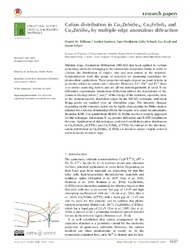Cation distribution in Cu2ZnSnSe4, Cu2FeSnS4 and Cu2ZnSiSe4 by multiple‐edge anomalous diffraction
Többens, Daniel M.
Gurieva, Galina
Niedenzu, Sara
Schuck, Götz
Zizak, Ivo
Schorr, Susan
DOI: https://doi.org/10.1107/S2052520620013384
Persistent URL: http://resolver.sub.uni-goettingen.de/purl?gldocs-11858/8456
Persistent URL: http://resolver.sub.uni-goettingen.de/purl?gldocs-11858/8456
Többens, Daniel M.; Gurieva, Galina; Niedenzu, Sara; Schuck, Götz; Zizak, Ivo; Schorr, Susan, 2020: Cation distribution in Cu2ZnSnSe4, Cu2FeSnS4 and Cu2ZnSiSe4 by multiple‐edge anomalous diffraction. In: Acta Crystallographica Section B, Band 76, 6: 1027 - 1035, DOI: 10.1107/S2052520620013384.
 |
Dokument öffnen: |
Multiple‐Edge Anomalous Diffraction (MEAD) has been applied to various quaternary sulfosalts belonging to the adamantine compound family in order to validate the distribution of copper, zinc and iron cations in the structure. Semiconductors from this group of materials are promising candidates for photovoltaic applications. Their properties strongly depend on point defects, in particular related to cation order–disorder. However, Cu+, Zn2+ and Fe2+ have very similar scattering factors and are all but indistinguishable in usual X‐ray diffraction experiments. Anomalous diffraction utilizes the dependency of the atomic scattering factors f′ and f′′ of the energy of the radiation, especially close to the element‐specific absorption edges. In the MEAD technique, individual Bragg peaks are tracked over an absorption edge. The intensity changes depending on the structure factor can be highly characteristic for Miller indices selected for a specific structural problem, but require very exact measurements. Beamline KMC‐2 at synchrotron BESSY II, Berlin, has been recently upgraded for this technique. Anomalous X‐ray powder diffraction and XAFS compliment the data. Application of this technique confirmed established cation distribution in Cu2ZnSnSe4 (CZTSe) and Cu2FeSnS4 (CFTS). In contrast to the literature, cation distribution in Cu2ZnSiSe4 (CZSiSe) is shown to adopt a highly ordered wurtz‐kesterite structure type. Multiple‐Edge Anomalous Diffraction (MEAD) has been applied to various quaternary sulfosalts belonging to the adamantine compound family in order to validate the distribution of copper, zinc and iron cations in the structure. Application of this technique confirms established cation distribution in Cu2ZnSnSe4 (CZTSe) and Cu2FeSnS4 (CFTS), but in Cu2ZnSiSe4 (CZSiSe) the cation distribution is shown to adopt a highly ordered wurtz‐kesterite structure type in contrast to the literature.
image
Statistik:
ZugriffsstatistikSammlung:
This is an open access article under the terms of the Creative Commons Attribution License, which permits use,
distribution and reproduction in any medium, provided the original work is properly cited.

